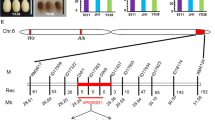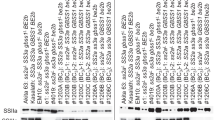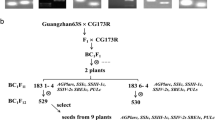Abstract
Key Message
Coordinated regulation of amylose and amylopectin synthesis via manipulation of SSII-2, SSII-3 and Wx expression in endosperm can improve rice eating and cooking quality.
Abstract
With increasing rice consumption worldwide, many researchers are working to increase the yield and improve grain quality, especially eating and cooking quality (ECQ). The rice ECQ is mainly controlled by the expression of starch synthesis-related genes (SSRGs) in endosperm. Although the Wx and SSII-3/SSIIa/ALK genes, two major SSRGs, have been manipulated to improve rice ECQ via various breeding approaches, new methods to further improve ECQ are desired. In our previous study, we enhanced rice ECQ by knocking down SSII-2 expression in the japonica Nipponbare cultivar (carrying the Wxb allele) via RNA interference. Herein, the SSII-2 RNAi was introduced into two Nipponbare-derived near-isogenic lines (NILs), Nip(Wxa) and Nip(wx), carrying Wxa and wx alleles respond for high and no amylose levels, respectively. Analysis of physicochemical properties revealed that the improved grain quality of SSII-2 RNAi transgenic lines was achieved by coordinated downregulating the expression of SSII-2, SSII-3 and Wx. To further confirm this conclusion, we generated ssii-2, ssii-3 and ssii-2ssii-3 mutants via CRISPR/Cas9 technique. The amylopectin structure of the resulting ssii-2sii-3 mutants was similar to that in SSII-2 RNAi transgenic lines, and the absence of SSII-2 decreased the amylose content, gelatinisation temperature and rapid visco-analyser profile, indicating essential roles for SSII-2 in the regulation of amylopectin biosynthesis and amylose content in rice endosperm. The effect of SSII-2 was seen only when the activity of SSII-3 was very low or lacking. Our study provides novel approaches and valuable germplasm resources for improving ECQ via plant breeding.





Similar content being viewed by others
Data availability
All data supporting the findings of this study are available within the paper and within its supplementary materials published online.
References
Anacleto R, Badoni S, Parween S, Butardo VM Jr., Misra G, Cuevas RP et al (2019) Integrating a genome-wide association study with a large-scale transcriptome analysis to predict genetic regions influencing the glycaemic index and texture in rice. Plant Biotechnol J 17:1261–1275
Bao JS, Corke H, Sun M (2006) Nucleotide diversity in starch synthase IIa and validation of single nucleotide polymorphisms in relation to starch gelatinization temperature and other physicochemical properties in rice (Oryza sativa L.). Theor Appl Genet 113:1171–1183
Bello BK, Hou Y, Zhao J, Jiao G, Wu Y, Li Z et al (2019) NF-YB1-YC12-bHLH144 complex directly activates Wx to regulate grain quality in rice (Oryza sativa L.). Plant Biotechnol J 17:1222–1235
Cai X, Wang Z, Xing Y, Zhang J, Hong M (1998) Aberrant splicing of intron 1 leads to the heterogeneous 5′ UTR and decreased expression of Waxy gene in rice cultivars of intermediate amylose content. Plant J 14:459–465
Chen K, Wang Y, Zhang R, Zhang H, Gao C (2019) CRISPR/Cas genome editing and precision plant breeding in agriculture. Annu Rev Plant Biol 70:667–697
Chen Z, Lu Y, Feng L, Hao W, Li C, Yang Y et al (2020) Genetic dissection and functional differentiation of ALKa and ALKb, two natural alleles of the ALK/SSIIa gene, responding to low gelatinization temperature in rice. Rice 13:39
Commuri PD, Keeling PL (2001) Chain-length specificities of maize starch synthase I enzyme: studies of glucan affinity and catalytic properties. Plant J 25:475–486
Crofts N, Abe N, Oitome NF, Matsushima R, Hayashi M, Tetlow IJ et al (2015) Amylopectin biosynthetic enzymes from developing rice seed form enzymatically active protein complexes. J Exp Bot 66:4469–4482
Donohoue PD, Barrangou R, May AP (2018) Advances in industrial biotechnology using CRISPR-Cas systems. Trends Biotechnol 36:134–146
Fan X, Li Y, Lu Y, Zhang C, Li E, Li Q et al (2019) The interaction between amylose and amylopectin synthesis in rice endosperm grown at high temperature. Food Chem 301:125258
Fire A, Xu S, Montgomery MK, Kostas SA, Driver SE, Mello CC (1998) Potent and specific genetic interference by double-stranded RNA in Caenorhabditis elegans. Nature 391:806–811
Fu FF, Xue HW (2010) Coexpression analysis identifies rice starch regulator1, a rice AP2/EREBP family transcription factor, as a novel rice starch biosynthesis regulator. Plant Physiol 154:927–938
Fujita N, Yoshida M, Asakura N, Ohdan T, Miyao A, Hirochika H, Nakamura Y (2006) Function and characterization of starch synthase I using mutants in rice. Plant Physiol 140:1070–1084
Furukawa K, Tagaya M, Inouye M, Preiss J, Fukui T (1990) Identification of lysine 15 at the active site in Escherichia coli glycogen synthase. Conservation of Lys-X-Gly-Gly sequence in the bacterial and mammalian enzymes. J Biol Chem 265:2086–2090
Gao Z, Zeng D, Cui X, Zhou Y, Yan M, Huang D et al (2003) Map-based cloning of the ALK gene, which controls the gelatinization temperature of rice. Sci China C Life Sci 46:661–668
Gu F, Gong B, Gilbert RG, Yu W, Li E, Li C (2019) Relations between changes in starch molecular fine structure and in thermal properties during rice grain storage. Food Chem 295:484–492
Harn C, Knight M, Ramakrishnan A, Guan H, Keeling PL, Wasserman BP (1998) Isolation and characterization of the zSSIIa and zSSIIb starch synthase cDNA clones from maize endosperm. Plant Mol Biol 37:639–649
Hennen-Bierwagen TA, Liu F, Marsh RS, Kim S, Gan Q, Tetlow IJ et al (2008) Starch biosynthetic enzymes from developing maize endosperm associate in multisubunit complexes. Plant Physiol 146:1892–1908
Hirano HY, Eiguchi M, Sano Y (1998) A single base change altered the regulation of the Waxy gene at the posttranscriptional level during the domestication of rice. Mol Biol Evol 15:978–987
Huang L, Li Q, Zhang C, Chu R, Gu Z, Tan H et al (2020a) Creating novel Wx alleles with fine-tuned amylose levels and improved grain quality in rice by promoter editing using CRISPR/Cas9 system. Plant Biotechnol J 18:2164–2166
Huang L, Sreenivasulu N, Liu Q (2020b) Waxy editing: old meets new. Trends Plant Sci 25:963–966
Jeon JS, Ryoo N, Hahn TR, Walia H, Nakamura Y (2010) Starch biosynthesis in cereal endosperm. Plant Physiol Biochem 48:383–392
Jiang H, Dian W, Liu F, Wu P (2004) Molecular cloning and expression analysis of three genes encoding starch synthase II in rice. Planta 218:1062–1070
Li Z, Chu X, Mouille G, Yan L, Kosar-Hashemi B, Hey S et al (1999) The localization and expression of the class II starch synthases of wheat. Plant Physiol 120:1147–1156
Li H, Prakash S, Nicholson TM, Fitzgerald MA, Gilbert RG (2016) Instrumental measurement of cooked rice texture by dynamic rheological testing and its relation to the fine structure of rice starch. Carbohydr Polym 146:253–263
Li QF, Huang LC, Chu R, Li J, Jiang MY, Zhang CQ et al (2018) Down-regulation of SSSII-2 gene expression results in novel low-amylose rice with soft, transparent grains. J Agric Food Chem 66:9750–9760
Li C, Wu A, Yu W, Hu Y, Li E, Zhang C, Liu Q (2020) Parameterizing starch chain-length distributions for structure-property relations. Carbohydr Polym 241:116390
Liu L, Ma X, Liu S, Zhu C, Jiang L, Wang Y et al (2009) Identification and characterization of a novel Waxy allele from a Yunnan rice landrace. Plant Mol Biol 71:609–626
Liu F, Ahmed Z, Lee EA, Donner E, Liu Q, Ahmed R et al (2011) Allelic variants of the amylose extender mutation of maize demonstrate phenotypic variation in starch structure resulting from modified protein–protein interactions. J Exp Bot 63:1167–1183
Liu F, Romanova N, Lee Elizabeth A, Ahmed R, Evans M, Gilbert Elliot P et al (2012) Glucan affinity of starch synthase IIa determines binding of starch synthase I and starch-branching enzyme IIb to starch granules. Biochem J 448:373–387
Liu W, Xie X, Ma X, Li J, Chen J, Liu Y (2015) DSDecode: a web-based tool for decoding of sequencing chromatograms for genotyping of targeted mutations. Mol Plant 8:1431–1433
Miao J, Guo D, Zhang J, Huang Q, Qin G, Zhang X et al (2013) Targeted mutagenesis in rice using CRISPR-Cas system. Cell Res 23:1233–1236
Mikami I, Aikawa M, Hirano HY, Sano Y (1999) Altered tissue-specific expression at the Wx gene of the opaque mutants in rice. Euphytica 105:91–97
Mikami I, Uwatoko N, Ikeda Y, Yamaguchi J, Hirano HY, Suzuki Y, Sano Y (2008) Allelic diversification at the Wx locus in landraces of Asian rice. Theor Appl Genet 116:979–989
Miura S, Crofts N, Saito Y, Hosaka Y, Oitome NF, Watanabe T et al (2018) Starch synthase IIa-deficient mutant rice line produces endosperm starch with lower gelatinization temperature than japonica rice cultivars. Front Plant Sci 9:645–645
Morell MK, Kosar-Hashemi B, Cmiel M, Samuel MS, Chandler P, Rahman S et al (2003) Barley sex6 mutants lack starch synthase IIa activity and contain a starch with novel properties. Plant J 34:173–185
Naito Y, Yamada T, Matsumiya T, Ui-Tei K, Saigo K, Morishita S (2005) dsCheck: highly sensitive off-target search software for double-stranded RNA-mediated RNA interference. Nucleic Acids Res 33:W589–W591
Nakamura Y, Francisco PB, Hosaka Y, Sato A, Sawada T, Kubo A, Fujita N (2005) Essential amino acids of starch synthase IIa differentiate amylopectin structure and starch quality between japonica and indica rice varieties. Plant Mol Biol 58:213–227
Nishi A, Nakamura Y, Tanaka N, Satoh H (2001) Biochemical and genetic analysis of the effects of amylose-extender mutation in rice endosperm. Plant Physiol 127:459–472
Ohdan T, Francisco PB Jr, Sawada T, Hirose T, Terao T, Satoh H, Nakamura Y (2005a) Expression profiling of genes involved in starch synthesis in sink and source organs of rice. J Exp Bot 56:3229–3244
Ohdan T, Francisco PJT, Hirose T, Terao T, Satoh H, Nakamura Y (2005b) Expression profiling of genes involved in starch synthesis in sink and source organs of rice. J Exp Bot 56:3229–3244
Peng C, Wang Y, Liu F, Ren Y, Zhou K, Lv J et al (2014) FLOURY ENDOSPERM6 encodes a CBM48 domain-containing protein involved in compound granule formation and starch synthesis in rice endosperm. Plant J 77:917–930
Phing Lau WC, Latif MA, Rafii MY, Ismail MR, Puteh A (2016) Advances to improve the eating and cooking qualities of rice by marker-assisted breeding. Crit Rev Biotechnol 36:87–98
Sano Y (1984) Differential regulation of Waxy gene expression in rice endosperm. Theor Appl Genet 68:467–473
Sato H, Suzuki Y, Sakai M, Imbe T (2002) Molecular characterization of Wx-mq, a novel mutant gene for low-amylose content in endosperm of rice (Oryza sativa L.). Breed Sci 52:131–135
Seung D, Soyk S, Coiro M, Maier BA, Eicke S, Zeeman SC (2015) PROTEIN TARGETING TO STARCH is required for localising GRANULE-BOUND STARCH SYNTHASE to starch granules and for normal amylose synthesis in Arabidopsis. PLoS Biol 13:e1002080
Su Y, Rao Y, Hu S, Yang Y, Gao Z, Zhang G et al (2011) Map-based cloning proves qGC-6, a major QTL for gel consistency of japonica/indica cross, responds by Waxy in rice (Oryza sativa L.). Theor Appl Genet 123:859
Tan Y, Yu S, Xing Y, Xu C, Zhang Q, Li J (1999) The three important traits for cooking and eating quality of rice grains are controlled by a single locus in an elite rice hybrid, Shanyou 63. Theor Appl Genet 99:642–648
Tetlow IJ, Beisel KG, Cameron S, Makhmoudova A, Liu F, Bresolin NS et al (2008) Analysis of protein complexes in wheat amyloplasts reveals functional interactions among starch biosynthetic enzymes. Plant Physiol 146:1878–1891
Tian Z, Qian Q, Liu Q, Yan M, Liu X, Yan C et al (2009) Allelic diversities in rice starch biosynthesis lead to a diverse array of rice eating and cooking qualities. Proc Natl Acad Sci USA 106:21760–21765
Umemoto T, Yano M, Satoh H, Shomura A, Nakamura Y (2002) Mapping of a gene responsible for the difference in amylopectin structure between japonica-type and indica-type rice varieties. Theor Appl Genet 104:1–8
Wang L, Wang YJ (2001) Comparison of protease digestion at neutral pH with alkaline steeping method for rice starch isolation. Cereal Chem 78:690–692
Wang Z, Wu Z, Xing Y, Zheng F, Guo X, Zhang W, Hong M (1990) Nucleotide sequence of rice Waxy gene. Nucleic Acids Res 18:5898–5898
Wang JC, Xu H, Zhu Y, Liu QQ, Cai XL (2013) OsbZIP58, a basic leucine zipper transcription factor, regulates starch biosynthesis in rice endosperm. J Exp Bot 64:3453–3466
Wang C, Shen L, Fu Y, Yan C, Wang K (2015) A simple CRISPR/Cas9 system for multiplex genome editing in rice. J Genet Genom 42:703–706
Wang X, Pang Y, Wang C, Chen K, Zhu Y, Shen C et al (2016) New candidate genes affecting rice grain appearance and milling quality detected by genome-wide and gene-based association analyses. Front Plant Sci 7:1998
Wang W, Wei X, Jiao G, Chen W, Wu Y, Sheng Z et al (2019) GBSS-BINDING PROTEIN, encoding a CBM48 domain-containing protein, affects rice quality and yield. J Integr Plant Biol 62:948–966
Xie X, Ma X, Zhu Q, Zeng D, Li G, Liu Y (2017) CRISPR-GE: a convenient software toolkit for CRISPR-based genome editing. Mol Plant 10:1246–1249
Xu Y, Lin Q, Li X, Wang F, Chen Z, Wang J et al (2020a) Fine-tuning the amylose content of rice by precise base editing of the Wx gene. Plant Biotechnol J 19:11–13
Xu Z, Yu M, Yin Y, Zhu C, Ji W, Zhang C et al (2020b) Generation of selectable marker-free soft transgenic rice with transparent kernels by downregulation of SSSII-2. Crop J 8:53–61
Yang Y, Guo M, Sun S, Zou Y, Yin S, Liu Y et al (2019) Natural variation of OsGluA2 is involved in grain protein content regulation in rice. Nature Commun 10:1949
Zeng D, Liu T, Ma X, Wang B, Zheng Z, Zhang Y et al (2020) Quantitative regulation of Waxy expression by CRISPR/Cas9-based promoter and 5’UTR-intron editing improves grain quality in rice. Plant Biotechnol J 18:2385–2387
Zhang C, Zhu L, Shao K, Gu M, Liu Q (2013) Toward underlying reasons for rice starches having low viscosity and high amylose: physiochemical and structural characteristics. J Sci Food Agric 93:1543–1551
Zhang H, Zhang J, Wei P, Zhang B, Gou F, Feng Z et al (2014) The CRISPR/Cas9 system produces specific and homozygous targeted gene editing in rice in one generation. Plant Biotechnol J 12:797–807
Zhang C, Zhou L, Zhu Z, Lu H, Zhou X, Qian Y et al (2016) Characterization of grain quality and starch fine structure of two japonica rice (Oryza Sativa) cultivars with good sensory properties at different temperatures during the filling stage. J Agric Food Chem 64:4048–4057
Zhang H, Xu H, Feng M, Zhu Y (2018) Suppression of OsMADS7 in rice endosperm stabilizes amylose content under high temperature stress. Plant Biotechnol J 16:18–26
Zhang C, Zhu J, Chen S, Fan X, Li Q, Lu Y et al (2019a) Wxlv, the ancestral allele of rice Waxy gene. Mol Plant 12:1157–1166
Zhang H, Zhou L, Xu H, Wang L, Liu H, Zhang C et al (2019b) The qSAC3 locus from indica rice effectively increases amylose content under a variety of conditions. BMC Plant Biol 19:275
Zhao DS, Li QF, Zhang CQ, Zhang C, Yang QQ, Pan LX et al (2018) GS9 acts as a transcriptional activator to regulate rice grain shape and appearance quality. Nat Commun 9:1240
Zhou H, Wang L, Liu G, Meng X, Jing Y, Shu X et al (2016) Critical roles of soluble starch synthase SSIIIa and granule-bound starch synthase Waxy in synthesizing resistant starch in rice. Proc Natl Acad Sci USA 113:12844–12849
Zhou H, Xia D, He Y (2020) Rice grain quality—traditional traits for high quality rice and health-plus substances. Mol Breed 40:1
Zhu F (2018) Relationships between amylopectin internal molecular structure and physicochemical properties of starch. Trends Food Sci Technol 78:234–242
Zhu L, Gu M, Meng X, Cheung SC, Yu H, Huang J et al (2012) High-amylose rice improves indices of animal health in normal and diabetic rats. Plant Biotechnol J 10:353–362
Zhu Q, Zeng D, Yu S, Cui C, Li J, Li H et al (2018) From golden rice to aSTARice: bioengineering astaxanthin biosynthesis in rice endosperm. Mol Plant 11:1440–1448
Acknowledgements
This work was supported by National Natural Science Foundation of China (31825019 and 31901517), the Ministry of Agriculture of China (2016ZX08001006-005), the programs from Jiangsu Province Government (CX(20)3004 and PAPD), and Young Elite Scientists Sponsorship Program by China Association for Science and Technology (2018QNRC001).
Author information
Authors and Affiliations
Contributions
QQL, QFL and HL conceived the project; LH, ZG, ZC, JY, RC, HT, DZ and XF performed the experiments and analysed the data; LH, QQL and QFL wrote the manuscript.
Corresponding authors
Ethics declarations
Conflict of interest
The authors have no conflicts of interest to declare.
Additional information
Publisher’s Note
Springer Nature remains neutral with regard to jurisdictional claims in published maps and institutional affiliations.
Supplementary Information
Below is the link to the electronic supplementary material.
Rights and permissions
About this article
Cite this article
Huang, L., Gu, Z., Chen, Z. et al. Improving rice eating and cooking quality by coordinated expression of the major starch synthesis-related genes, SSII and Wx, in endosperm. Plant Mol Biol 106, 419–432 (2021). https://doi.org/10.1007/s11103-021-01162-8
Received:
Accepted:
Published:
Issue Date:
DOI: https://doi.org/10.1007/s11103-021-01162-8




